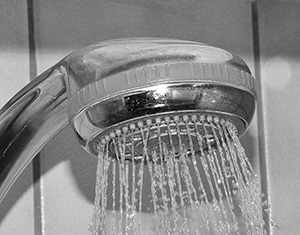 Seven years ago, I learned that many of the substances used in conventional toiletries were harmful. I’ll admit that I was shocked and surprised. I’d believed that modern scientific knowledge, together with regulation, guaranteed greater safety in our shampoos, soaps, and toothpastes.
Seven years ago, I learned that many of the substances used in conventional toiletries were harmful. I’ll admit that I was shocked and surprised. I’d believed that modern scientific knowledge, together with regulation, guaranteed greater safety in our shampoos, soaps, and toothpastes.
It was a jolt to discover that this was not so.
I was particularly interested in the fact that sodium lauryl sulfate and sodium laureth sulfate are profoundly irritating to the skin. These two chemicals were in nearly every cleansing product on the shelf and inescapable in shampoo.
The reason for my interest was that my scalp had been chronically irritated for most of my adult life. The only shampoo that kept the irritation down to a manageable level was Selsun Blue. And even that was not 100% effective. There was always a small patch somewhere – behind one ear, behind the other ear, right at the crown, or wherever – that was itchy and scaling.
With my new knowledge, I suspected that SLS was causing the irritation. Which meant that most shampoos would be problematic for me, and explained why Selsun Blue was less than ideal. The active ingredient, selenium sulfide, soothed my irritated scalp, but the SLS inflamed it.
My search for an alternative was arduous.
Many of the alternatives had substances in their ingredient lists that were just as harmful as those in conventional products. And those that did not proved to be even more irritating to my scalp.
I blogged about my search in 2012, hoping that my experiences might save someone else all the trial and error. Finding a safe and effective shampoo was much more difficult than finding a good lip balm, a good hand lotion, or a good soap.
SLS was the main ingredient used to provide the slipperiness that removes dirt from hair.
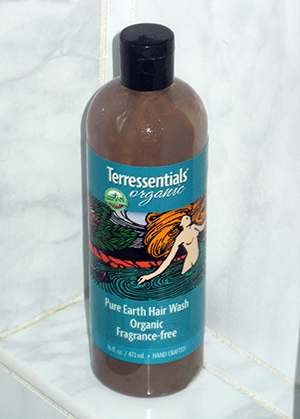 Then I stumbled upon Terressentials hair wash. It’s not a soap or a shampoo at all. Bentonite clay, formed from the weathering of volcanic ash, serves as the basis of its cleansing power.
Then I stumbled upon Terressentials hair wash. It’s not a soap or a shampoo at all. Bentonite clay, formed from the weathering of volcanic ash, serves as the basis of its cleansing power.
The hair wash worked for me, and for the first time ever, my scalp healed fully and stayed healed. I was delighted.
There was just one hitch: the consistency of the hair wash was very thick, which made it difficult to work through my below-the-shoulder length hair.
The Terresentials instructions said not to add water to the bottle. I suspect the reason for this was that if the hair wash were stored for a long time, the added water would provide a medium in which bacteria could grow, since there were no preservatives in the ingredients list.
The liquid proportion of the hair wash seemed to be provided by aloe vera juice.
So I purchased a bottle of aloe vera juice, figuring that I could add it to the hair wash myself for greater liquidity.
It didn’t work at all. Oh, it made the hair wash more liquid. But it also left a strange residue on my hair, yielding a slightly tacky feel.
I abandoned the addition of aloe vera juice and learned instead to apply the hair wash immediately after ducking my head under the shower, so that my hair was sopping wet. This allowed me to work the hair wash all the way through my tresses.
It was somewhat cumbersome, but worth it for the fantastic results. I loved having a fully healthy scalp.
I eventually learned that I used the hair wash quickly enough that I could add water to the bottle without any bacterial growth occurring.
I was set!
Until Terressentials changed their recipe.
They never announced any change, no doubt because the ingredients in their hair wash did not change. But the proportions changed. The hair wash gradually became more liquid, and it started to leave that slightly tacky residue on my hair that I’d noticed when I myself added aloe vera juice.
This made me very unhappy.
I continued to use the hair wash, because my hair was clean. It still looked good, and my scalp stayed healthy. The tackiness on each strand was very slight. Still, I didn’t like it.
I started scrutinizing the ingredient lists of alternative shampoos again. None were the least bit promising.
Then I remembered a book on my shelves that I’d purchased long before my Great Soap Quest of 2010. I believe I’d obtained the book just for the sheer fun of experimenting with mixing up my own beauty potions, but I can’t really recall much. 😉
I’d used one recipe to give my mother an at-home “spa” experience, when she complained that her hair was as dry as straw. Not only was that fun, but it worked wonderfully well.
 Her hair really was as dry as straw. After I’d applied the Refried Bean Hair Masque (a combination of avocado, refried beans, and various oils), it was entirely restored.
Her hair really was as dry as straw. After I’d applied the Refried Bean Hair Masque (a combination of avocado, refried beans, and various oils), it was entirely restored.
Perhaps there would be a shampoo recipe in that book that would work equally well for me.
There was, but only one.
Out of the 14 shampoo recipes in the chapter on hair, 13 used a base of commercial baby shampoo to which other pantry ingredients were added. (Banana, apple juice, beer, et cetera.)
The recipe without commercial shampoo had the following ingredients:
• 1 tablespoon apple cider vinegar
• 1 tablespoon lemon extract
• 3 egg yolks
• 1/2 cup lukewarm water
I whisked up a batch and tried it.
I could tell almost as soon as I rubbed it into my hair that it would not work. My scalp hurt!
But I was also sure I knew what the offending ingredients were: the apple cider vinegar and the lemon extract. What if I simply used lemon juice instead? I’d been using a homemade lemon rinse for months (made with lemon juice, not extract) and found it very soothing.
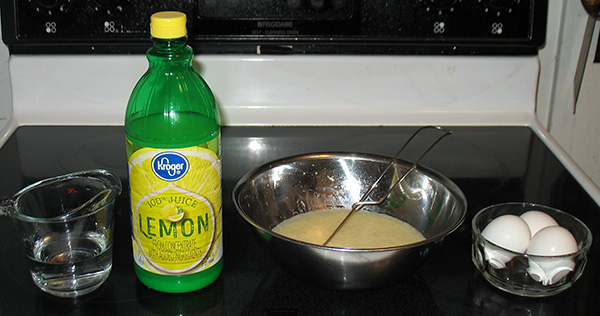
So I made adjustments to the recipe:
• 2 tablespoons lemon juice
• 3 egg yolks
• 1/2 cup lukewarm water
And it worked!
My hair was shiny and clean and with no tacky residue. My scalp was calm.
However, over the course of three of four hair washings, I found my hair became ever so slightly oily. Not badly so, but still.
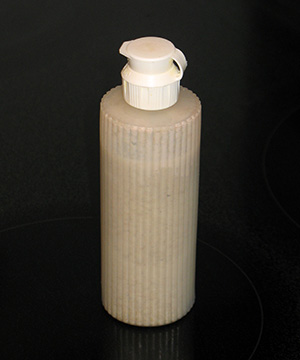 At that point, with the DIY bit firmly between my teeth, I remembered something I’d read while researching my lemon hair rinse. The author of the Kanelstrand blog had developed a hair wash based on rye flour. What about that?
At that point, with the DIY bit firmly between my teeth, I remembered something I’d read while researching my lemon hair rinse. The author of the Kanelstrand blog had developed a hair wash based on rye flour. What about that?
I returned to her site and read up.
The nice thing about a rye flour slurry is that it possesses the properly acidic pH, just like the lemon hair rinse does. But would it really work to clean my hair?
It took me a while to acquire rye flour. Would you believe it: my ordinary supermarket no longer carries it!
Back when I still ate bread, I used to bake my grandmother’s Swedish rye bread several times a year. Was I the last woman baking rye bread in my locality or something? When I stopped baking, did the market then stop acquiring rye flour? Probably not! 😉
But I had to make a special trip to the health food store to get some.
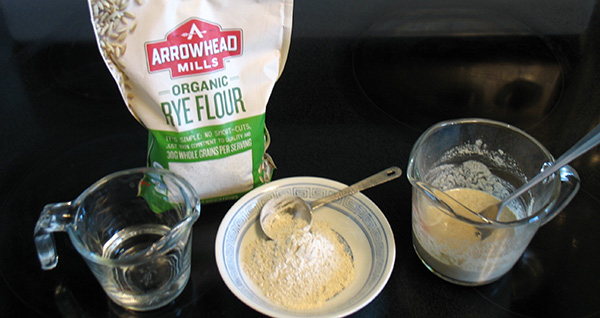
The Kanelstrand blogger didn’t specify measurements, merely explaining that she added water to a portion of rye flour until she achieved a thick slurry similar in consistency to most shampoos: liquid enough to pour, not so thin that it would seep through the fingers of your cupped hand.
This worked out to be a one-to-one ratio when I tried it for myself.
I make 3/8 cup at a time, right before I’m going to wash my hair:
• 3 tablespoons water
• 3 tablespoons rye flour
I use all of it. There’s no soapy, slippery ingredient that will allow a small amount to spread easily through a large mass of hair (which I have). So I need a large amount.
But it works!
My hair is shiny and clean, and the slight oiliness from the egg-based shampoo is gone.
I suspect, however, that I might be most happy if I use both DIY shampoos in some pattern of alternation, because as I type this my hair feels a little dry.
Perhaps every third washing should be done with the egg shampoo. Or the reverse. I’ll be experimenting with what works best.
I’ll leave you with some notes on the storage needs of these DIY shampoos. They really cannot be stored on the edge of the tub or in the bathroom cabinet, because they are food. They’ll spoil at room temperature.
The egg shampoo is much slipperier than the rye shampoo, so I get two hair washings from one batch. Therefore, I divide the batch in two, using one portion immediately, and freezing the other.
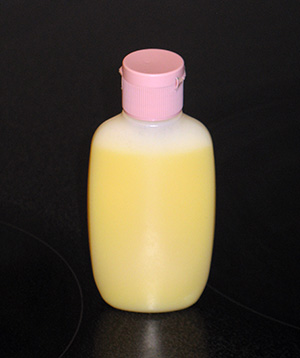 When I was using only the egg shampoo, it lasted fine in the refrigerator. But now that I plan to alternate between egg and rye, the interval is likely to be too long for refrigerator storage to work. Thus, the freezer. It’s very easy to quick thaw by immersing the ziplock bag in warm tap water.
When I was using only the egg shampoo, it lasted fine in the refrigerator. But now that I plan to alternate between egg and rye, the interval is likely to be too long for refrigerator storage to work. Thus, the freezer. It’s very easy to quick thaw by immersing the ziplock bag in warm tap water.
I use the full batch of the rye shampoo, but it also lasts several days in the refrigerator, as I discovered when I made my initial (and larger) batch.
If I were traveling, I would simply bring the bag of rye flour, which does not require refrigeration, because I could mix it with water when I needed it. No doubt I’ll see how that works in practice when I next go up to my parents’ home for an extended visit. 😀
For more about alternative toiletries, see:
Great Soap & Etcetera Quest
Great “Soap” Eureka!
Why To Add a Lemon Rinse to Your Hair Care Routine

The things you have to go through when the conventional solutions (pun intended) all have the same flaw!
I have a friend who stopped using shampoo completely. I don’t remember what she uses instead, or whether she still does this, but I understand the frustration.
Glad you found a solution. But glad, too, that there is a shampoo that turns my dry frizzy old lady hair (where the heck did that come from?) back into wonderful sleek hair that feels like hair. Hair matters, even if it is a first-world problem.
Indeed! And such flaws exist on all levels, from the trivial through the chronically problematic to the life-and-death important. It’s definitely an imperfect world! But every solution counts. Or so I think. 🙂
I’ve been noticing the “bouncing-Bet” / soapwort blooming ( pale pink, roadside flower). It’s root is supposed to have a sudsy effect…
Lately I’ve experimented with shampooing, etc. my hair while still braided,…( I figured people with dreadlocks look to have clean hair… ) and it worked really well!
I’ve really fine hair so the less it gets handled the less breakage. I’ve let it dry overnight in the braid as well… It seems to be doing well.
Your recipes look interesting, thanks for sharing! Perhaps a lactose free skim milk? No sugar for sticky and no fat for greasy…
A friend simply dissolves borax in water and uses that for a hair and body wash…
I’m intrigued by your friend’s borax wash. I wonder what the pH is for borax…I’ll have to do a little research! Thanks for sharing your experiences, Kathleen.
I checked the pH on borax, and it is alkaline. Hair and skin generally do better with solutions that match their pH, which is acidic. FYI. 😉